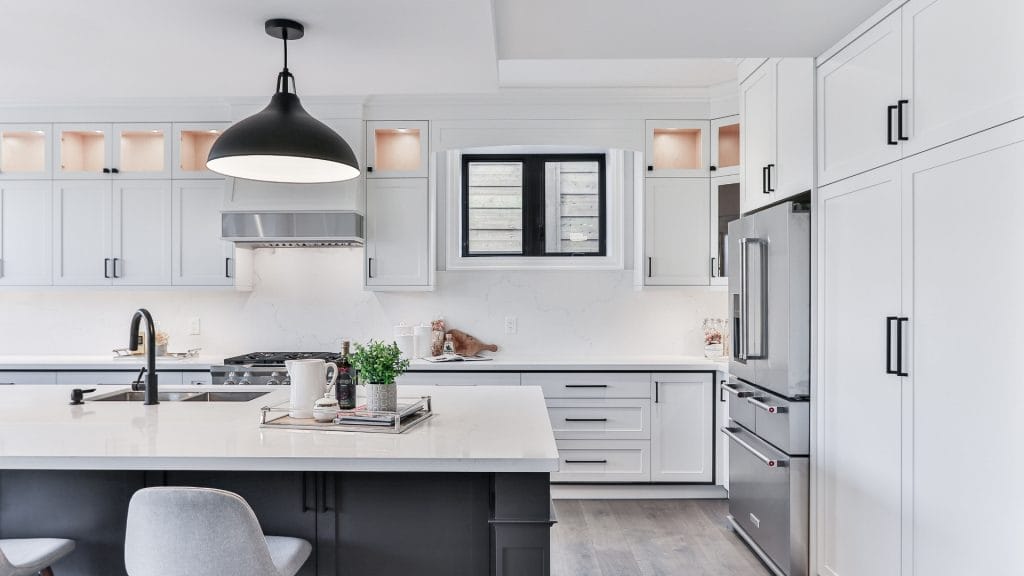Space-Waste Management: How to Eliminate Dead Zones in Your Kitchen
The dreaded dead zone: spaces in your kitchen that are inefficient, impractical, or even unusable.
Sometimes dead zones can appear due to a lack of design foresight or subpar planning. Like your kitchen’s very own Bermuda Triangle, things disappear into these dead zones, never to be seen or used again.
No one wants them in their kitchen, and their presence is even more intolerable in an already small space. Dead zones are an unfortunate, nagging reminder of lost potential that could be put to better use – but they can be rectified with a bit of careful reorganization.
Don’t let wasted space get you down! It’s easy to get the most out of every square inch of kitchen and make it look good while doing it.
Seek and Destroy: Identifying Your Dead Zones
Here are a few tips and tricks for turning those kitchen dead zones into usable space.
Upper Cabinets
 The space above your upper cabinets may be out of reach, but they don’t have to be out of touch. Although this area is inaccessible for daily use (unless you’re seven-foot-something), it’s still a perfect spot to get some visual appeal. Don’t keep your collections hidden away; let them complement your kitchen design from an upper perch.
The space above your upper cabinets may be out of reach, but they don’t have to be out of touch. Although this area is inaccessible for daily use (unless you’re seven-foot-something), it’s still a perfect spot to get some visual appeal. Don’t keep your collections hidden away; let them complement your kitchen design from an upper perch.
Show off your rarely-used decorative dishware, low maintenance potted plants (the less you have to get up there to water them, the better), framed photographs, and other eye-catching knick-knacks. Just remember not to overdo it. You want to highlight your existing design, not outshine it. Keep it relatively sparse. Cramming this area with too much stuff will just end up looking crowded and messy.
The area below your upper cabinets is where you can keep frequently-used items without crowding up the countertop. You can attach spice racks, hanging stemware racks, hooks to hang mugs or utensils, or even a magnetic strip to display your knives. Not only is this super handy and accessible for your everyday use, but it also offers a hint of your culinary talents to anyone who might drop by.
Lower Cabinets
 Lower cabinets are notorious for becoming a labyrinthine maze of neglected foodstuffs, stacks of pots and pans, and other kitchen trappings. Finding and removing stuff from lower cabinet dead zones can quickly become a frustrating game of kitchen Jenga. There’s nothing worse than digging through an entire cabinet’s contents on your hands and knees to find an item buried at the back.
Lower cabinets are notorious for becoming a labyrinthine maze of neglected foodstuffs, stacks of pots and pans, and other kitchen trappings. Finding and removing stuff from lower cabinet dead zones can quickly become a frustrating game of kitchen Jenga. There’s nothing worse than digging through an entire cabinet’s contents on your hands and knees to find an item buried at the back.
Transform those dead zones, optimize, and reorganize with a sliding shelf inside for easier access. You can often stack at least two inside a single cabinet, which allows you to store twice the average amount of stuff.
And what about the much-maligned corner cabinet? You probably won’t be able to fit sliding shelves, but a rotating Lazy-Susan style shelf or cabinet organizer gives you 360-degree access to all those dark, nether reaches.
Hang In There
You can utilize cabinet doors or pantry doors in many unexpected ways. Install a hanging caddy or even a few hooks to store additional items. Stow anything that you might need, but would rather keep hidden from view. Think grocery and produce bags, Tupperware, mops, brooms, larger cleaning items, aprons, or the calendar.
Above, Below, and Beyond
 But what else can you do to maximize your kitchen space? Sure, you can achieve extra storage with a few well-placed organizational pieces, but if you want to go that extra mile, step back, and reassess the functionality of your kitchen design as a whole.
But what else can you do to maximize your kitchen space? Sure, you can achieve extra storage with a few well-placed organizational pieces, but if you want to go that extra mile, step back, and reassess the functionality of your kitchen design as a whole.
Most kitchen design adheres to the concept of “the kitchen triangle,” which helps you achieve optimal efficiency and traffic flow between work zones as you prep and cook.
Using this principle, think about how you use your kitchen, and where your most-used items are stored. Having your preferred tools close at hand will not only help you use your kitchen space more efficiently, but it will also make you a better cook. Okay, maybe not necessarily – but it never hurts! Certainly, when the dead zones are gone, and your spaces are accessible and maximized, it will be a lot easier to do everything you want to do.
Keep it practical, though. Keep pots and pans next to the stove, mugs, and coffee in the cupboard next to the kettle, and trash bins and daily cleaning supplies under the sink.
If your kitchen simply isn’t working for you, the design team at Winthorpe can help give you a kitchen layout that’s just right. Connect with us today, and let’s talk about it.





